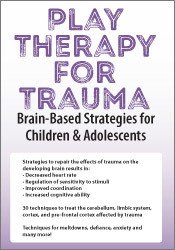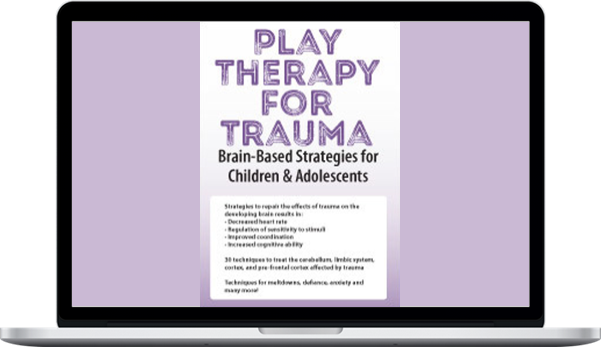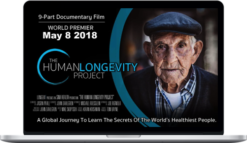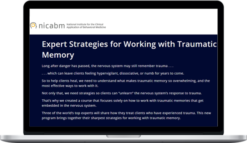Amy Flaherty – Play Therapy for Trauma
$109.00 $28.00
Total Sold: 1
»Instant Delivery
Description
Amy Flaherty – Play Therapy for Trauma
Description of Play Therapy for Trauma

Techniques to repair the brain and improve:
- Attachment and regulation through Theraplay and Brain Gym exercises
- Coping skills and emotional identification through play techniques
- Executive function for positive choices through sand tray, art therapy and CBT
Are you struggling to find creative, effective, brain-based techniques to help your kids who suffer from anxiety, impulsivity, isolation and defiance as a result of trauma?
Join Amy Flaherty, to discover innovative brain-based techniques, such as sandtray, art, and movement exercises to use in the play room to increase cognitive ability, regulate sensitivity to stimuli, and improve coordination. You will leave with confidence to design, tailor, and apply play therapy techniques using the backing of solid neuroscience.
Learn to recognize trauma loops, dysregulation, regression, rigidity in your clients, and discover countless and effective play therapy techniques to heal them. Take advantage of the latest brain-research to effectively treat common trauma-related behaviors, such as:
- Repetitive movement
- Isolation
- Meltdowns
- Defiance
- Harm to self and others
- and many more!
Videos, case studies, and experiential techniques will be used to fully explain play therapy techniques and the latest brain research.
What you’ll learn in Play Therapy for Trauma
Objectives
- Describe the structure and function of the brain, with a focus on the developing brain.
- Explain the specific effects of trauma on the brain.
- List 5 behavioral symptoms that result from environmental or physical trauma.
- List 2 play therapy techniques to repair the limbic system for emotional Identification.
- Apply the principles of interpersonal neurobiology in the play room.
- Describe using rhythm play therapy techniques to relegate the cerebellum.
Outline
Overview of the Effect of Trauma on the Brain
- Age-appropriate play
- Environmental vs physical
- Long-lasting effects: ACES score
- Protective factors with trauma
- Importance of attachment research
Five distinct symptoms of trauma within play therapy
- Principles of Interpersonal Neurobiology in Play Therapy
- The Domains of Integration
- The divided brain and why it matters
- How play therapy is able to regulate and allow the person to move up and down the brain system as needed
- Case examples to demonstrate lack of integration
REPAIRING THE BRAIN THROUGH PLAY TECHNIQUES – OVER 30 TECHNIQUES
Techniques for dysregulation, rigidity, regression, trauma loops (targets cerebellum)
- Rhythm games and songs
- Attachment activities
- Touch in play – when appropriate, best practices
Techniques for emotional identification (targets the limbic system)
- Color my heart activity
- Name that feeling
- Angry balloon game
- Angry volcano experiment
- Butterflies in my tummy
- What’s different in the sand tray
Techniques for coping skills to address rigidity, trauma loops, and harmful behaviors (targets the cortex)
- Mad Libs assertiveness skill game
- I can calm down hand game
- Breathing games
- Calm down bottle/sensory bottle
- Positive self-talk
- Biblothearpy in the play room
Techniques to improve executive function for positive choices: After body is regulated and the whole brain is online (targets the pre-frontal cortex)
- Vision board
- Sandtray directives
- Draw headstone
- Carrying shame stones
- Board of directors
Best practices for parents/caregivers
- Name it to tame it
- ACT method
- What research says about the importance of parents working on their own stories
About Amy Flaherty
Amy Flaherty is a Licensed Psychological Examiner-Independent, and a RPT in Northeast Arkansas. She has been working with children as well as adults in the outpatient counseling setting for over 10 years. Amy taught intensive play therapy classes for the past several years.
In addition to the 150 hours of classes she completed to earn her play therapy credential, she also studied under Theresa Kestly at the Sandtray Institute of New Mexico, completing over 100 hours of intensive study of how the brain works in sandtray and play therapy. Amy blogs and speaks regularly about all things sandtray and play therapy and was featured on the website of the Association of Play Therapy for her work with Pam Dyson of the DFW Center for Play Therapy. Amy is a dynamic, interactive speaker, weaving real life case studies with brain-informed research to provide an overall understanding of play therapy.
More courses from the same author: Amy Flaherty
Delivery Policy
When will I receive my course?
You will receive a link to download your course immediately or within 1 to 21 days. It depends on the product you buy, so please read the short description of the product carefully before making a purchase.
How is my course delivered?
We share courses through Google Drive, so once your order is complete, you'll receive an invitation to view the course in your email.
To avoid any delay in delivery, please provide a Google mail and enter your email address correctly in the Checkout Page.
In case you submit a wrong email address, please contact us to resend the course to the correct email.
How do I check status of my order?
Please log in to HealingCourse account then go to Order Page. You will find all your orders includes number, date, status and total price.
If the status is Processing: Your course is being uploaded. Please be patient and wait for us to complete your order. If your order has multiple courses and one of them has not been updated with the download link, the status of the order is also Processing.
If the status is Completed: Your course is ready for immediate download. Click "VIEW" to view details and download the course.
Where can I find my course?
Once your order is complete, a link to download the course will automatically be sent to your email.
You can also get the download link by logging into your HealingCourse account then going to Downloads Page.
Related products
Total sold: 3









